The Aaf Application Is Unavailable Please Try Again Later
The coffee you poured an hour ago is water ice common cold. There are a half-dozen text messages on your telephone asking where the video is. All you had to do was make one tiny modify to the video and upload information technology in time for it to be played at the conference.
BEEP!
It won't consign. You try again. "Why is this happening?!" you ask yourself as you read the seemingly foreign linguistic communication in the error box that's popped up in Media Composer.
BEEP! No, no, no!
Don't worry. Take a deep breath. This article will teach you how to troubleshoot this problem and many other bug in Media Composer using a few common troubleshooting techniques.
I've spent nearly the last decade as a senior video editor, and often the but video editor, for companies. This has led me to countless situations like the above example with no one to turn to. The vast majority of errors I've run across are solved with the troubleshooting techniques below.
Tip #1: Turning It Off Then Dorsum On
"Have y'all reset your figurer?" It's the question every IT tech will enquire yous. And at that place's a reason. It works.
What Does Turning Your Figurer Off Then Dorsum On Attain?
Rebooting helps gives your computer a squeamish clean slate and frees up RAM, regardless of whether you are working on a Mac or PC
Picture this: you lot've been editing for 5 hours. You're colour correcting and playing back 4K footage. Spotify is playing on one of your 18 Chrome tabs and Photoshop is open from yesterday. Media Composer itself has been running for the last week.
The longer that each of these programs runs, the higher the likelihood that a bug will occur. A bug is usually caused past an unusual circumstance that the software developers didn't account for. Possibly y'all plugged in your headphones while Pro Tools was in the process of loading and you had just started playback in Media Composer, and that those simultaneous actions messed up your sound routing. Suddenly, your levels don't work properly, and you don't know why. The longer that the figurer is running, the more than opportunities there are for one of those unusual circumstances to happen. Rebooting clears all of that out and gives you a fresh start.
The other reason why rebooting helps is that it frees up all the RAM that those programs were using. You lot can have the beefiest computer simply at some point the pressure on the RAM volition be besides much. If you don't cut it slack, your reckoner will force your hand. Lack of RAM can crusade all kinds of random errors — especially in Media Composer.
This troubleshooting technique lonely solves more than than 50 percent of my Media Composer problems.
When Should Y'all Do This?
Nearly every time I come across a Media Composer problem, I restart my computer. Practice this when yous come across a playback event or when Media Composer does something out of character (i.e., it won't allow y'all export when null has inverse and you've been exporting all day).
How to Properly Plough Your Calculator Off Then Back On
Do non just hit the Restart push button! Get-go, shut your reckoner all the way down. Side by side wait at least x seconds, if not longer. Catch a fresh cup of coffee if you need to.
With your new cup of java in hand, plough your figurer back on and meet if your problem has been stock-still.
Tip #two: Checking File Path to Media and Re-Indexing Databases
Imagine it's viii:fifteen a.m. You're in the office early to become a spring on the project yous were editing yesterday. You lot open your sequence and you run into red, literally. All of your media is offline!
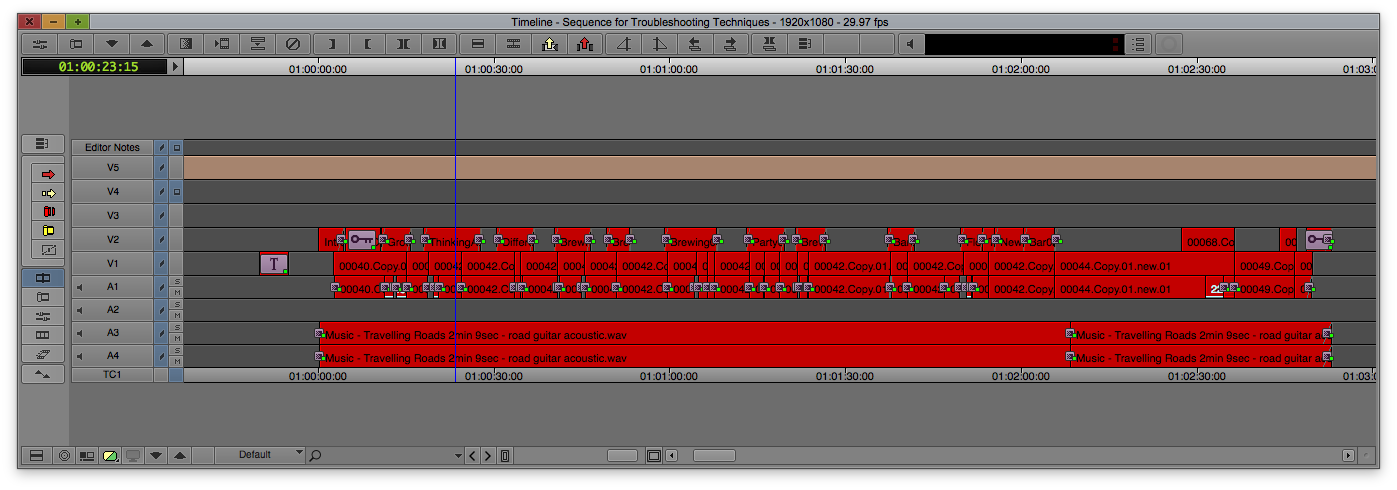
At that place's no need to panic. At that place's a good chance that one) the file path to your media somehow was changed or 2) Media Composer for any reason isn't able to read your media. To troubleshoot this problem, we're going to check the file path to your media, and if needed, forcefulness Media Composer to re-alphabetize your media databases.
What Does Checking Your Media's File Path and Re-Indexing Your Databases Accomplish?
Checking the file path ensures that Media Composer can read your media. Re-indexing ensures that Media Composer does read your media.
When Should Y'all Check for Media'southward File Path and Re-Index Your Databases?
You should do this whenever your media is offline and it shouldn't exist. For example, you were working on a projection 1 24-hour interval so the adjacent mean solar day all your media is offline and goose egg has changed in your workflow.
How to Bank check Your File Path to Media and Re-Alphabetize Databases
Before doing anything make sure you've quit out of Media Composer.
Media Composer will merely read media if there is a specific file path on a difficult drive. That file path is the same for both Macs and PCs (though the slashes go in different directions). From the root level of any hard drive your media must exist as follows:
[hard drive] > Avid MediaFiles > MXF > 1
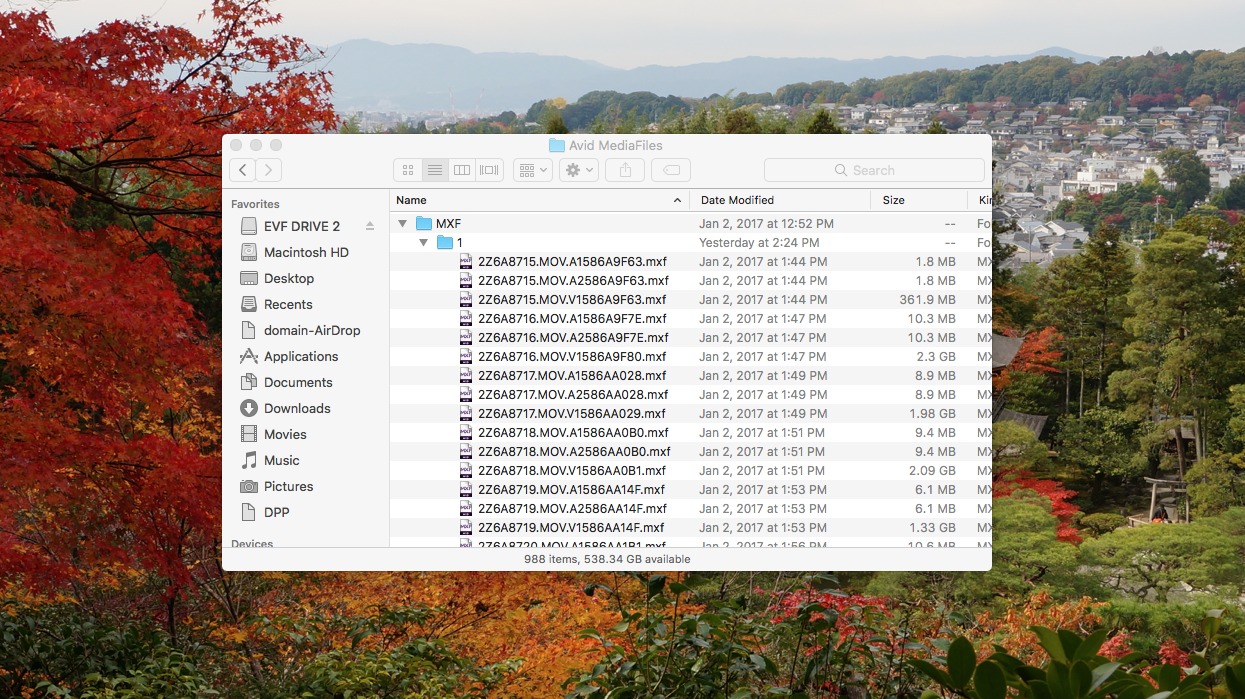
Within that "1" folder is a binder labeled "Creating" and two database files (more than on these in a moment). The "1" folder'south name tin be inverse and might already be inverse if you're on a shared storage environment like an Avid NEXIS or Facilis TerraBlock. Otherwise, the file path has to be exactly like this downward to the character. Note: there is no infinite in MediaFiles.
If your file path is wrong, fix information technology. Someone may accept moved the Gorging MediaFiles folder or accidentally changed the name of the MXF folder.
Once the file path is fixed, launch Media Composer. If your media is withal offline, it's fourth dimension to re-alphabetize the databases.
Media Composer catalogues your media (the MXF files inside of the "1" binder) so they link with the primary clips yous meet in your bins. Sometimes Media Composer likes to ignore the database files it has for one reason or another. To remedy this, inside the "1" folder delete these two files and re-launch Media Composer:
- msmMMOB.mdb
- msmFMID.pmr
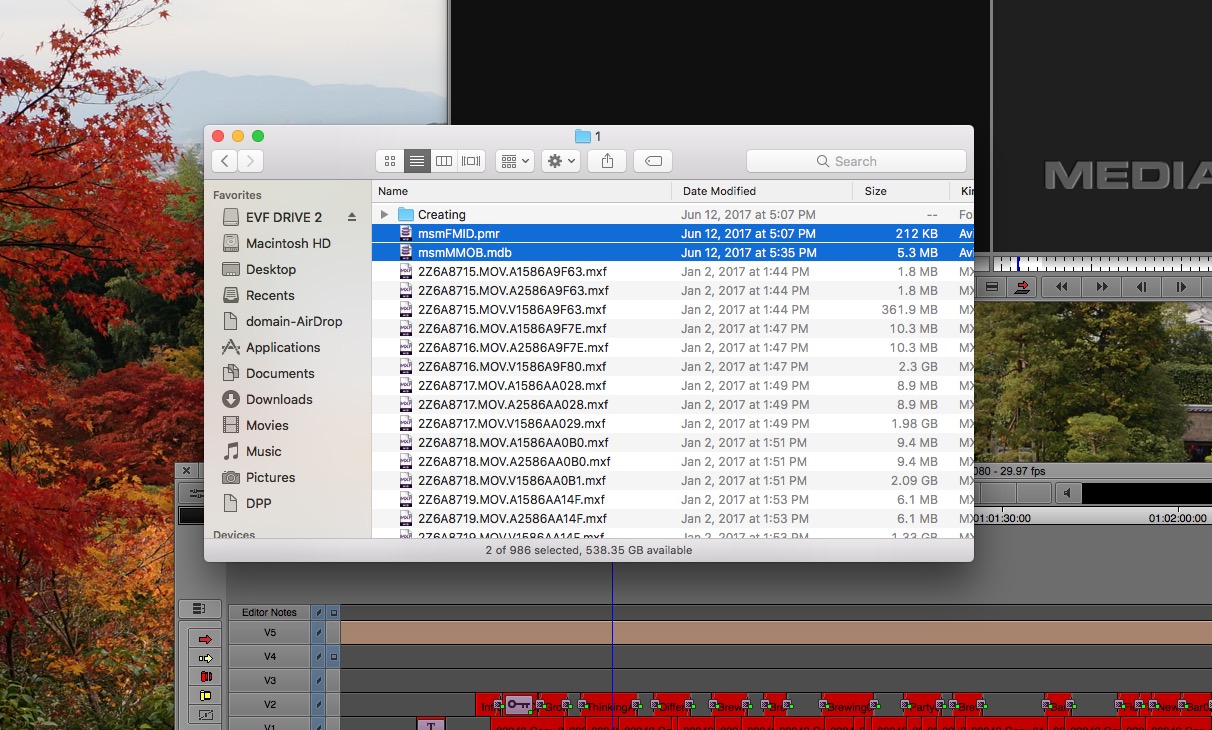
Delete them. It'south okay. If you don't trust me, put them on your desktop for the fourth dimension existence and delete them after.
If in that location is more than than one "1" folder, become into those folders also and delete the database files.
In a shared storage surround in that location's a slight difference. Instead of a "i" folder each computer in system is given a name. Any media created on a figurer will get into their estimator's folder. To force Media Composer to re-index all the media you must m ove the MXF files into your computer's specific binder.
In my shared storage environment, my computer is named AVID4.one. The other systems in my shared storage environment are AVID1.1, Gorging 2.1 and AVID3.1. When I need to re-index, I move whatever MXF files that are in the AVID1.1, AVID2.1 and AVID3.1 folders into my AVID4.one folder.
Adjacent launch Media Composer.
Media Composer volition at present re-index your media. A couple dialogue boxes will automatically appear on launch. This may have a few minutes depending on the corporeality of media. When information technology's done, open your projection. Chances are your media is back online.

For what it's worth, I accept to do this troubleshooting technique once every 2-3 weeks.
Tip #3: New User Profile
Media Composer uses User Profiles so that an editor can modify preferences, screen layouts, keyboard shortcuts and other settings so the preferred wait and feel is always the same. Occasionally, User Profiles become corrupted causing a broad multifariousness of issues. Some examples include non assuasive you to import an alpha channel on an image, or continually defaulting new sound files to OMF media instead of MXF media.
When an fault similar this occurs try a make new User Profile.
How to Create a New User Profile
To create a new User Profile, go to the Settings tab of the Project Window. Click the drib-downwards next to User Profile: and select Create User Contour.
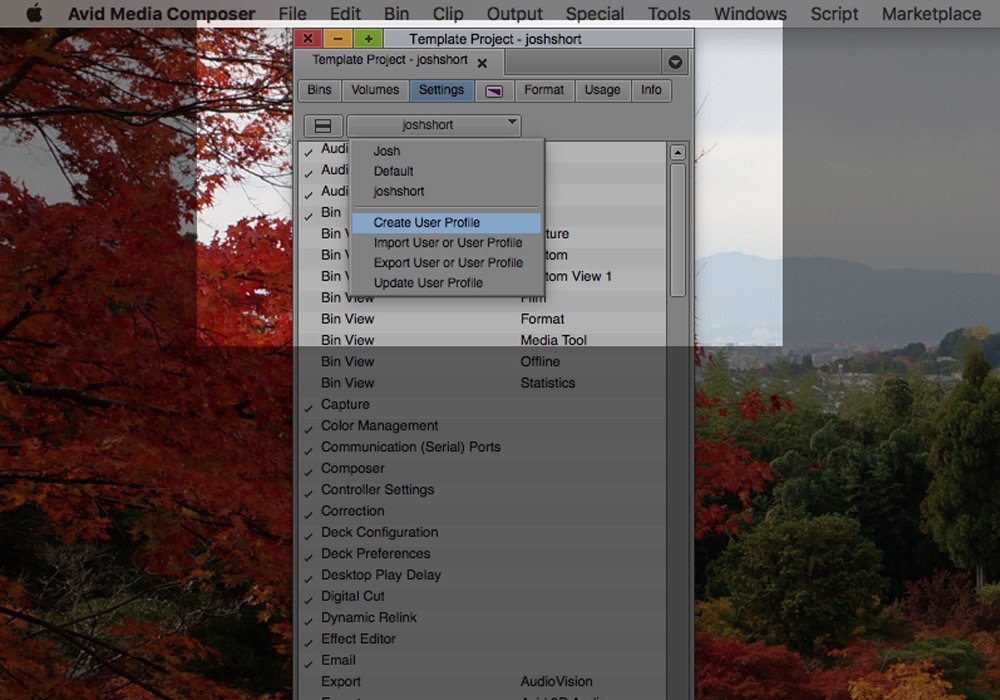
One time the new User Profile is agile, come across if this fixed your consequence.
Tip #4: Finding a Decadent Clip Using the Guess-and-Cheque Formula
Anytime you open a project, in that location's a minuscule hazard that a prune will be corrupted. This most probable happens when a project sits inactive for a long time or there's been a number of software updates since it was last opened. When a clip gets corrupted, Media Composer doesn't directly tell you lot or what clip information technology is (wouldn't that exist nice?).
How to Tell If You lot Have a Corrupt Clip
You could take a decadent clip if yous receive an "Exception" error when opening a bin, saving a bin or playing a sequence or an "Assertion Failed" error while attempting to export.
How to Find a Corrupt Prune
Exercise yous remember doing the "guess-and-check formula" in middle school Algebra class? With the guess-and-check formula, yous work the trouble backwards to attempt to notice the answer. Y'all can do the aforementioned thing in Media Composer to observe a corrupt clip.
If there's a corrupt clip, Media Composer won't exist able to copy it into the Source Monitor. The easiest way to cheque if there's a corrupt clip is to select all the tracks in the sequence and set an in-bespeak and out-point on the first and last frames. Then use the keyboard shortcut Opt+C (Mac) or Alt+C (PC) to copy everything selected to the Source Monitor. If you accept a corrupt prune, Media Composer should give you an fault and not copy information technology to the Source Monitor. If it does copy to the Source Monitor, yous more than than probable practise not accept a corrupt prune.
If the clips don't copy to the Source Monitor, at that place's a good chance one of the clips is corrupted. So nosotros need to narrow in on it. Keeping all the tracks selected, put an in-betoken at the beginning of your timeline and an out-betoken halfway through the sequence. This is where you showtime guessing at an answer. Hit Opt+C/Alt+C again. If there'southward an error, then the corrupt clip is in that one-half of the sequence. If no fault, do the same thing for the 2nd one-half of the sequence.
Once you discover the half with the error do the aforementioned thing again. Select half of the half and hit Opt+C/Alt+C. Continue going until you lot detect the few seconds that Media Composer won't let yous copy to the Source Monitor. From here, use the Friction match Frame tool which is plant in the Command Palette to individually load each clip around that time into the Source Monitor. The decadent prune won't be able to exist loaded into the Source Monitor using Lucifer Frame.
Media Composer by and large won't let y'all edit over or edit out a corrupt clip, so you have to recreate your sequence. Create a new bin and a new sequence. Give it the same tracks yous have in the sequence with the corrupt clip. Use the same Opt+C/Alt+C shortcut to re-create your sequence with the exception of the decadent prune.
Discover the bin where the decadent clip resides and re-import or re-capture, if possible. Then edit it dorsum into the new sequence.
Tip #v: Unlocking a Locked Bin
One of Media Composer's greatest strengths is its ability to run the aforementioned projection on multiple computers at once in a shared storage environment. The simply grab is that only i editor can have a specific bin open at a time. If another editor tries to open the bin, it will be locked and simply a copy of the bin tin exist saved. Once the first editor closes out of the bin, Media Composer unlocks information technology so the other editor can open up information technology up and make changes.
Nonetheless, occasionally Media Composer won't unlock the bin for one reason or another. One usual culprit are computer crashes. When your computer crashes it'll typically lock the bins you lot had open. That means no one can access the bins that were open until the computer reboots. If you're similar me, and you work on an aging HP that takes forever to fully kicking and reconnect to the network, you might not exist able to wait. But look, there's a workaround!
How to Unlock a Locked Bin
When you open a Media Composer bin in a shared storage environment, information technology creates a .lck file. This file is located in Media Composer's project folder wherever the project resides.
Find the Media Composer project on the media workspace. If yous don't know where this is, when yous launch Media Composer there should be projects listed on the launch screen. Click the binder icon and that'll show you where those projects reside.
![]()
Once you lot discover your project's folder, open up it up. Find the bin you need to unlock. Let's say it's named "Opening Credits". Find the file named Opening Credits.lck. Delete this file. And poof! Your bin is unlocked.
There will also be a file named Opening Credits.avb. This is the bin itself. Go out this file alone! One final caution, never practice this while someone is actually working on that bin. Bin locking is there for a reason.
Tip #6: Update Media Composer
When all else fails, earlier going through the long and laborious procedure of uninstalling and reinstalling Media Composer, check for a software update. This should exist a last resort—updating tin can often cause more issues than information technology resolves.
What Does Updating Media Composer Practise?
Bugs are fixed in each new release. Your outcome could be one of those bugs. Bank check out Avid Blog's rundown each time they release a new update.
How to Update Media Composer
Open up Avid Awarding Director. Under the Apps tab, find Gorging Media Composer and encounter if there is a new version to download.
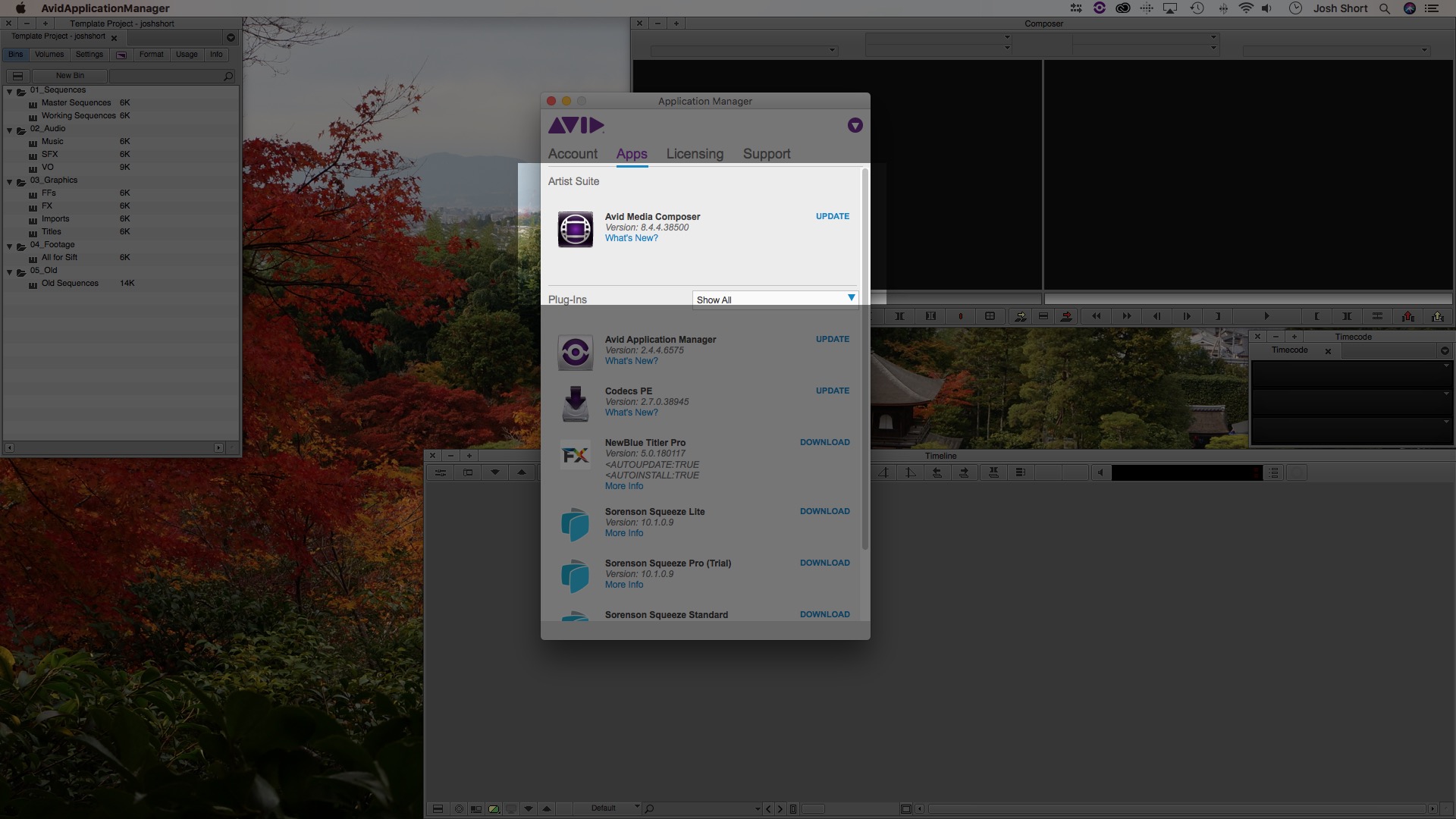
Summing Upward
Media Composer doesn't always cooperate when yous need it to. Errors and problems will arise. Nonetheless, many of them can be solved with these troubleshooting techniques. They may take time and patience, only they're worth trying when things go wrong. Take your own troubleshooting techniques? Share them in the comments.
If you also use Premiere Pro, you might savour our similar article on The 9 Most Common Crashes in Premiere Pro, and How to Ready Them.
Epilogue – A Few More Tips
After an outpouring of response on this article'south social media postings, I wanted to add a few more than suggestions.
The Console
The keyboard shortcut Cmd+6 (Mac) or Ctrl+6 (PC) opens the Console. The Console can show you errors that occurred, you tin can view other data and alter the way Media Composer behaves. If Media Composer is interim up, apply the keyboard shortcut to open up upwardly the Console and take a expect around. You can also find the Panel under the Tools menu.
WARNING: Do NOT type commands into the Console unless you lot know what you are doing. You lot can do some serious damage in hither.
Observe Error Logs
You can find mistake logs on your hard drive in instance you lot weren't able to catch a screenshot.
On a Mac look hither:
Macintosh Hd/Users/Shared/AvidMediaComposer/Avid FatalErrorReports
On a PC look here:
C:\ProgramData\Avid\Support\Logs
Delete Project Settings
If your project is crashing and you're not sure why, you lot can try to delete your Project Settings.
Like to Tip #two: Checking File Path to Media and Re-Indexing Databases , you lot can delete Project Settings and have them automatically rebuild when yous launch a project.
Starting time, quit out of Media Composer. Find your Project file location (see How to Unlock a Locked Bin under Tip #5). You'll run into 2 files: [projection proper name] Settings.avs and [project name] Settings.xml . Delete (or stash temporarily on your desktop if you're untrusting) and so re-launch Media Composer. This forum thread goes into much further item.
Source: https://blog.frame.io/2018/02/19/avid-media-composer-troubleshooting-tips/
0 Response to "The Aaf Application Is Unavailable Please Try Again Later"
Publicar un comentario